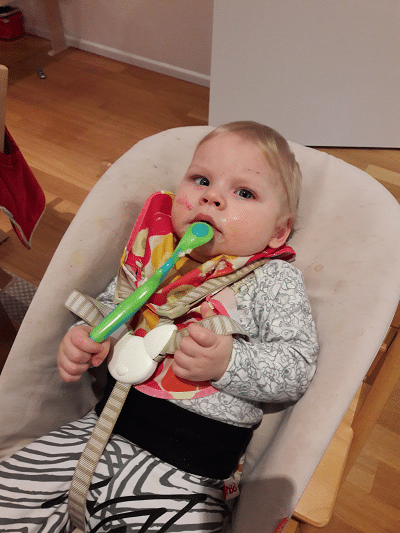Feeding difficulties is a broad term. Overall, a feeding situation is considered abnormal if the duration of a meal exceeds 30 minutes, if very frequent meals are necessary (more than every 2 hours) or if there is increased choking/coughing when eating.
The Situation With PCH2 Children
Ensuring an adequate fluid and food supply, as well as administering medication orally if necessary, is a key aspect of caring for children with PCH2.
Feeding difficulties are very common in children with PCH2. They usually occur from a young age and improvements with increasing age have only been reported in individual cases.
In PCH2, impaired oral motor skills (e.g. closing the mouth around the spoon/teat) and swallowing difficulties are particularly evident, so that some of the food flows out of the mouth again. In addition, the patient may choke with coughing and gagging, and be affected by general restlessness and motor disorder, which makes eating more difficult. In severe cases, choking can lead to aspiration, i.e. food or liquids entering the airways. If the coughing stimulus is not sufficient to clear the airways, this can lead to inflammation of the lungs (pneumonia).
Many parents report that their children are only able to eat finely pureed, mushy food. They also report that their children find it easier to swallow thickened food/liquids rather than more runny purees or plain liquids.
Some families reported an improvement of the feeding situation thanks to the insertion of a PEG tube. A PEG (percutaneous endoscopic gastrostomy) tube is an endoscopically created access from the outside through the abdominal wall into the stomach used for artificial feeding. This allows a continuous and sufficient intake of fluids and nutrients (and medication if necessary) but it can also be used only as required while the child continues to be fed orally. On the other hand, there are the risks associated with the surgical procedure of inserting a PEG tube; however, this is not the subject of this article and must be considered individually by parents and doctors in each case.
Another option for tube feeding is a nasogastric tube. However, most children do not tolerate this well and it may only be a temporary solution.
Tips to Try Out
- Introduce routines before mealtimes to prepare the children for the meal to come (table song or slogan, showing and explaining spoon and food, etc.).
- Despite the difficulties mentioned above, try to create a relaxed and calm eating environment and adapt to the child’s eating pace.
- Keep the child securely in place while eating to minimize problems caused by uncoordinated movements during feeding.
- Have regular (possibly smaller and more frequent) meals.
- Use thickened liquids instead of plain liquids.
- Finely puree food.
- Avoid highly acidic foods (see reflux).
- Use special cups with a soft rim.
- Speech therapy to improve oral motor skills and swallowing (if practical).
- Nasogastric tube or PEG tube.
Scientific Background
Feeding and swallowing difficulties are described in all publications as a typical symptom of PCH2. The literature available up to 2014 did not report an improvement in feeding difficulties with increasing age.
Data From Literature
- In Barth et al. (1995), 6 out of 18 children already had feeding difficulties in the neonatal period (in the first month of life).
- Budde et al. (2008) described 46 of 51 children with feeding difficulties.
- Steinlin et al. (2007) observed feeding difficulties in 13 of 21 cases.
- Namavar et al. (2011) found feeding difficulties in 68 out of 69 cases.
- Valayannopoulos et al. (2012) found them in 5 out of 6 cases.
- Claßen et al. (2019) point out the high incidence of feeding difficulties in children with neurological disabilities, with particular emphasis on oropharyngeal dysphagia, gastroesophageal reflux and constipation. Therefore, they argue that nutritional and gastroenterological expertise should be a regular part of the care of patients with such complex conditions.
Natural History Study from 2014
Feeding or swallowing difficulties were defined as choking, coughing while drinking/eating, uncoordinated swallowing, duration of a meal ˃ 30 min. Up to the age of 6 months, all of the 33 children who took part in the study developed feeding difficulties. These improved in 2 cases as the children got older. In 21 cases, a PEG tube had to be inserted, and 8 of these children were fed exclusively via the tube.
Natural History Study from 2023
Feeding difficulties occurred in 52 out of 53 children within the first few months of life. Only one child (aged 3 ) showed no feeding difficulties. In 4 cases, the feeding situation improved significantly within the first 2 years of life. Overall, all parents reported an improvement of feeding difficulties through targeted training and that the problem depended on the respective day.
This entry was written to the best of our knowledge based on the reported experiences of parents of affected children. In addition, currently available data from the 2014 and 2023 Natural History Studies of PCH2 and from general medical literature has been included. It is not a substitute for consulting a medical professional. PCH2cure assumes no liability in this respect.
- Barth P G, Blennow G, Lenard H-G, Begeer J H, van der Kley J M, Hanefeld F, Peters A C B, Valk J (1995) The syndrome of autosomal recessive pontocerebellar hypoplasia, microcephaly, and extrapyramidal dyskinesia (pontocerebellar hypoplasia type 2): Compiled data from 10 pedigrees. Neurology 45: 311-317
- Budde B S, Namavar Y, Barth P G, Poll-The B T, Nürnberg G, Becker C, van Ruissen F, Wetermann M A, Fluiter K, te Beek E T, Aronica E, van der Knaap M S, Hohne W, Toliat M R, Crow Y J, Steinlin M, Voit T, Roelenso F, Brussel W, Brockmann K, Kyllerman M, Boltshauser E, Hammersen G, Willemsen M, Basel-Vanagaite L, Krägeloh-Mann I, de Vries L S, Sztriha L, Muntoni F, Ferrie C D, Battini R, Hennekam R C, Grillo E, Beemer F A, Stoets L M, Wollnik B, Nurnberg P, Baas F (2008) tRNA splicing endonuclease mutations cause pontocerebellar hypoplasia. Nat Genet 40 (9): 1113-1118
- Claßen M, Schmidt-Choudhury A (2019) Ernährungsprobleme und Unterernährung bei schwer neurologisch beeinträchtigten Kindern und Jugendlichen. Monatsschrift Kinderheilkunde Edition 8/2019
- Namavar Y, Barth P G, Kasher P R, van Ruissen F, Brockmann K, Bernert G, Writzl K, Ventura K, Cheng E Y, Ferriero D M, Basel-Vanagaite L, Eggens V R, Krägeloh-Mann I, De Meirleir L, King M, Graham J M, Jr., von Moers A, Knoers N, Sztriha L, Korinthenberg R, Dobyns W B, Baas F, Poll-The B T (2011) Clinical, neuroradiological and genetic findings in pontocerebellar hypoplasia. Brain 134(Pt 1): 143-156
- Steinlin M, Klein A, Haas-Lude K, Zafeiriou D, Strozzi S, Müller T, Gubser-Mercati D, Schmitt Mechelke T, Krägeloh-Mann I, Boltshauser E (2007) Pontocerebellar hypoplasia type 2: variability in clinical and imaging findings. Eur J Paediatr Neurol 11 (3): 146-152
- Valayannopoulos V, Michot C, Rodriguez D, Hubert L, Saillour Y, Labrune P, de Laveaucoupet J, Brunelle F, Amiel J, Lyonnet S, Enza-Razavi F, Attié-Bitach T, Lacombe D, Bahi-Buisson N, Desguerre I, Chelly J, Burglen L, Boddaert N, de Lonlay P (2012) Mutations of TSEN and CASK genes are prevalent in pontocerebellar hypoplasias type 2 and 4. Brain 135:1-5
- Natural History Study from 2014: Frölich S. Natürlicher Verlauf der Pontocerebellären Hypoplasie Typ 2 [Inauguraldissertation zur Erlangung des Doktorgrades der Medizin] Tübingen: Eberhard-Karls-Universität; 2014
- Natural History Study from 2023: Kuhn A L. Gastrointestinale Symptome, Ernährung und Gedeihen bei Pontocerebellärer Hypoplasie Typ 2 A [Inauguraldissertation zur Erlangung des Doktorgrades der Medizin] Freiburg im Breisgau: Albert-Ludwigs-Universität; 2023

